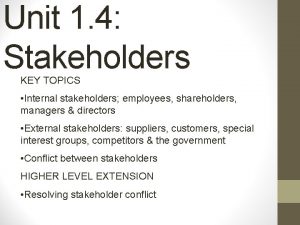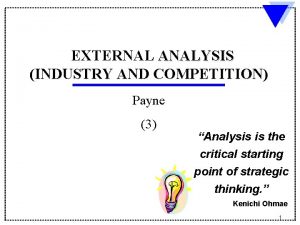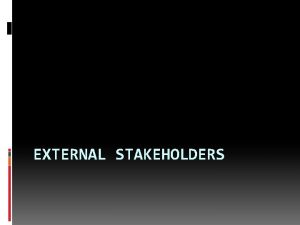Meeting the Needs of Stakeholders Internal and External














- Slides: 14

Meeting the Needs of Stakeholders Internal and External Stakeholder Analysis

Should Penny Cut Her Hair?

What are Stakeholders? Stakeholders are groups of people who have an interest in the activities of a business They can be seen as being either external to the organization, or internal But some may be both!

Types of Stakeholder Owners (I) Shareholders (I) Managers (I) Staff or employees (I) Customers (E) Suppliers (E) Community (E) Government (E ) Rivals (E ) I = Internal E = External

Internal and External Stakeholders Internal stakeholders are those who are ‘members’ of the business organisation Owners and shareholders Managers Staff and employees External stakeholders are not part of the firm

But…. . ! Some groups can be both internal and external stakeholders Such as staff or shareholders who are also local community residents Can you think of any others?

Characteristics of Stakeholders 1. Owners and Shareholders The number of owners and the roles they carry out differ according to the size of the firm In small businesses there may be only one owner (sole trader) or perhaps a small number of partners (partnership) In large firms there are often thousands of shareholders, who each own a small part of the business

Characteristics of Stakeholders 2. Managers: organize make decisions plan control are accountable to the owner(s)

Characteristics of Stakeholders 3. Employees or Staff: A business needs staff or employees to carry out its activities Employees agree to work a certain number of hours in return for a wage or salary Pay levels vary with skills, qualifications, age, location, types of work and industry and other factors

Characteristics of Stakeholders 4. Customers: Customers buy the goods or services produced by firms They may be individuals or other businesses Firms must understand meet the needs of their customers, otherwise they will fail to make a profit or, indeed, survive

Characteristics of Stakeholders 5. Suppliers: Firms get the resources they need to produce goods and services from suppliers Businesses should have effective relationships with their suppliers in order to get quality resources at reasonable prices This is a two-way process, as suppliers depend on the firms they supply

Characteristics of Stakeholders 6. Community: Firms and the communities they exist in are also in a two-way relationship The local community may often provide many of the firm’s staff and customers The business often supplies goods and services vital to the local area But at times the community can feel aggrieved by some aspects of what a firm does

Characteristics of Stakeholders 7. Government: Economic policies affect firms’ costs (through taxation and interest rates) Legislation regulates what business can do in areas such as the environment and occupational safety and health Successful firms are good for governments as they create wealth and employment

Characteristics of Stakeholders 7. Rival firms: (last but not least) Innovation and product development from rival companies can “set the agenda” for a business, e. g. Apple watch influences Samsung product development Competitors may try to use their market power to exclude competition (price war) May not be important in all markets
 Key internal stakeholders
Key internal stakeholders Stakeholder internal and external
Stakeholder internal and external Internal vs external stakeholders
Internal vs external stakeholders Okayama moodle
Okayama moodle Internal stakeholders
Internal stakeholders External stakeholders
External stakeholders Internal stakeholders examples
Internal stakeholders examples Primary needs and secondary needs
Primary needs and secondary needs Satisfaction
Satisfaction Primary needs and secondary needs
Primary needs and secondary needs Strategic gender needs and practical gender needs
Strategic gender needs and practical gender needs Needs analysis definition
Needs analysis definition Unit 5 meeting individual needs
Unit 5 meeting individual needs Meeting the needs of guests with kindness and goodwill.
Meeting the needs of guests with kindness and goodwill. Health and social care unit 5 coursework example p3
Health and social care unit 5 coursework example p3

























